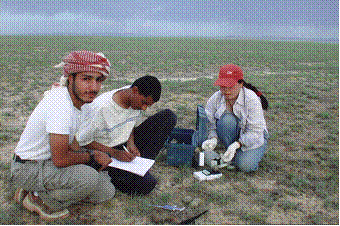Mulei Station for Wildlife Survey and Monitoring, XIEG, CAS
Introduction
Established in 2000, the Station is located in the south of the Junggar Gobi region at 44.04°N, 90.99°E about 80 km from Mori country. Between Mongolia and China, the area covers an alluvial plain in the eastern Junggar Basin with an average altitude of 800-1,000 m. The area is bordered by the Tianshan Mountains and contains typical desert ecosystems found in Central Asia. The soil is predominantly clay and gravel, with sand in the north. The climate is arid and cold (20°C on average in July, and –15°C on average in January). The mean annual rainfall is 150 mm, mostly falling in spring and winter. Various associations of sub-shrubs (Anabasis sp. and Artemisia sp.) dominate the vegetation in the core area. The vegetation is typically short (10–15 cm) with scattered tall shrubs (50–80 cm), predominantly Salsola arbuscula and Ceratoides latens. The Goitered Gazelle is one of the most common wild ungulate species in the Reserve. Other large ungulates present in the Reserve are the Kulan (Equus hemionus), and Argali (Ovis ammon). Houbara bustard (Chlamydotis undulata macqueenii) is a regular spring and summer visitor. Mori is an important breeding area for Houbara bustard. The animal species arrive from mid-April to late May, and depart between mid-September and mid-October.
Research Fields
(1) Trans-boundary and long-term monitoring of rare and endangered birds and ungulates occurring in this area
(2) Long-term monitoring of population dynamics and migration routes of wildlife that potentially carry serious diseases that could cause epidemics
(3) The feeding habits, habitat selection and behavior of wildlife, and the mechanisms of desert plant and animal interactions
Regular Monitoring
The population status of Houbara bustards is monitoringed twice per year in the Mori region.
Major Accomplishments
(1) Conservation biology of Houbara bustard (Chlamydotis undulata macqueenii)
The conservation biology of Houbara bustard was studied in Mori, Xinjiang, China, through cooperation with the National Avian Research Center, UAE in 1996. The researchers have studied the distribution and migration of the Houbara bustard in China by investigation and tracking by PTT satellite transmitter. The population ecology of Houbara in Xinjiang, including density and population size, genetic variation and evolution, and annual mortality rates of adult Houbara were also researched. Meanwhile, the researchers studied the incubating behavior, breeding success, growth rate of Houbara chicks, the ultra structure of Houbara eggshells, and Houbara habitat selection. More than 30 scientific papers have been published in international and Chinese journals, such as Ibis, Biological Conservation, Animal Conservation, Journal of Arid Environments, and Science in China.
Main publications
Combreau O, Qiao J, Lawrence M, et al. 2002. Breeding success in a Houbara Bustard Chlamydotis [undulata] macqueenii population on the eastern fringe of the Junggar Basin, People's Republic of China. Ibis, 144 (2): E45–E56.
Yang W K, Qiao J F, Combreau O, et al. 2003. Breeding habitat selection by the Houbara Bustard Chlamydotis [undulata] macqueenii in Mori, Xinjiang, China. Zoological Studies, 42(3): 470–475.
Tourenq C, Combreau O, Lawrence M, et al. 2005. Alarming houbara bustard population trends in Asia. Biological Conservation, 121(1): 1–8.
(2) Conservation biology of Goitred gazelle (Gazella subgutturosa) and wild ass (Equus hemionus)
From 2005, the conservation biology of Goitred gazelle and wild ass were studied in the Kalamaili Reserve through Geographic Information System (GIS) to assess the habitat suitability for Goitred gazelle. The habitat selection, natural diet, behavioral time budgets, and social structure of Goitred gazelle and wild ass were studied. More than 10 papers were published in Chinese Journals, including Acta Theriologica Sinica, Chinese Journal of Ecology, Arid Land Geography, and Arid Zone Research.

Measuring the nests and eggs of Houbara bustard

Houbara bustard
Main Publications
Li Y, Xu W X, Yang W K, et al. 2010. Habitat suitability assessment of Gazella subgutturosa in Kalamaili Mountain Nature Reserve. Acta Theriologica Sinica, 30(1): 11–20.
Xu W X, Yang W K, Qiao J F. 2009. Food habits of Kulan (Equus hemionus hemionus) in Kalamaili Mountain Nature Reserve, Xinjiang, China. Acta Theriologica Sinica, 29(4): 427–431.
Qiao J F, Yang W K, Xu W X, et al. 2008. Social structure of goitered gazelles (Gazella subguttrosa) in Kalamaili Mountain Nature Reserve, Xinjiang. Acta Theriologica Sinica. 28(4): 353–357.
Personnel
There are 10 research staffs in the Station, including 2 professors, 1 associate professor and 1 scientist of the Hundred Talents Program.
There are currently 6 postgraduate students in the Station, including 4 PhD candidates and 2 MSc candidates.
Contact
Director: Dr. YANG Weikang
Tel: +86-991-7885358
E-mail: Yangwk@ms.xjb.ac.cn
- Appendix
-



